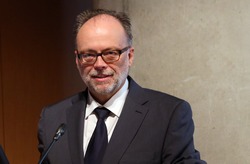The following article was published by Theo Dirix in his blog. He is one of the Vesalius Continuum project members and a contributor to this website. Theo Dirixis an author and a taphophile. He has successively held the office of Consul in Embassies of Belgium in Tanzania, Saudi Arabia, Jordan, Canada, the United Arab Emirates and, since 2011, Greece. His current posting is in Kopenhagen, Denmark Before 1989, he worked for the Flemish Radio 3 and commented on (mainly Moroccan) literature. He is constantly writing travel stories of his visits to cemeteries and graves. He is also the author of the book "In Search of Andreas Vesalius: The Quest for the Lost Grave".
“Andreas Vesalius is a rock star in well defined circles”, a friend wrote to me in an e-mail and: ”I hate disappointing people". That is to say with the results of the upcoming crucial phase in the search for his lost grave in Zakynthos, Greece. I guess she considers all 800 friends of my Vesalius Continuum Page as members of those "well defined circles". Let me assure her, and all of you, Vesalius groupies, that nobody will be disappointed.
Potential sponsors definitely won’t. They just have to ask Agfa HealthCare Greece, that has financed the Geographical Information System of the first phase. With the amount paid, a company cannot even buy a single add in a newspaper; Agfa got dozens of adds instead, during our talks, in publications and in this paragraph.
Neither will Vesalius groupies, even after a generous contribution to the crowd funding campaign. Beyond the pleasure of discovering a geophysical prospection, they can bid on the miniature facial reconstruction we will present here soon. Or on paintings of skulls, cells and blood; one of my mentors is already labeling his acrylic studies we will auction soon.
And finally, no scientist will. Of course, there are some who will grin if we find ... nothing, but they seem to forget that a non-discovery can be as important as a find. Many more, however, continue to encourage us. They know funerary slabs have already been found under the corner house of Kolyva/Kolokotroni in the city center, where we concentrate our search. I’ll never forget the reaction of an archaeologist when I showed her the pictures of those artefacts in Pavlos Plessas’s blog.
From pampalaia.blogspot.dk/2012/08/blog-post.html I quote:
"How many excavations would you say have taken place at this site, which could, and should, have been the focus of a universal cultural pilgrimage? As far as I know none! Unless of course the dynamites and the bulldozers that after the catastrophic earth-quakes of 1953 demolished any wall left standing and pushed it into the sea can be thought of as an archaeological dig."
Back to our plans: a team of four or five researchers will walk through that part of the town with a Ground Penetrating Radar device. They will drill small holes (of about one cm in diameter and twenty cm in depth) in the asphalt roads, pavements and surroundings to enter electrodes and carry out the Electrical Resistivity Tomography. To get permits for making the holes, have plans of any utility networks and carry out the fieldwork, this geophysical prospection will take five days maximum. After processing the survey, the research center IMS/FORTH, Rethymnon, will come up with a map of underground architectural remains.
How exiting is that? I'm looking forward to receiving your comments. Are you ready to register, to pledge your support ?
Personal note: Click on the following link to collaborate with this incredible quest. I already did. Dr. Miranda
GoFundMe Campaign for the next stage of the project




